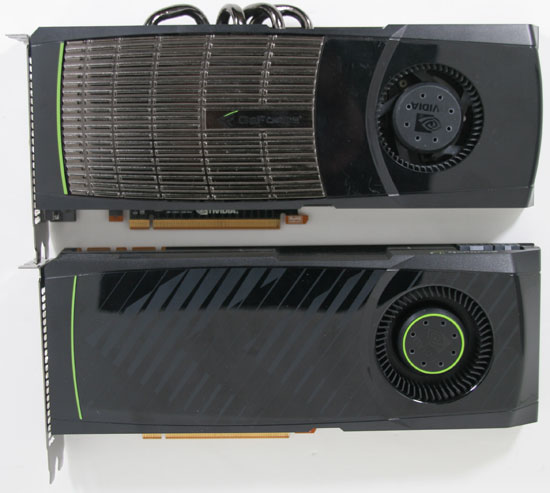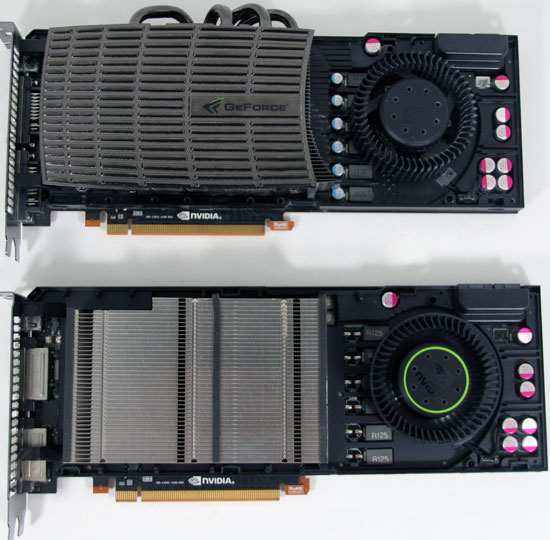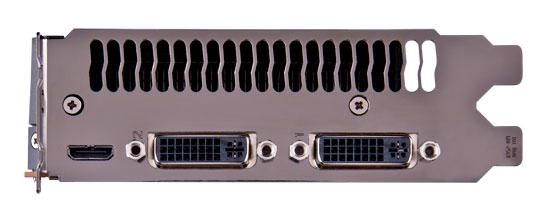NVIDIA's GeForce GTX 580: Fermi Refined
by Ryan Smith on November 9, 2010 9:00 AM ESTMeet the GTX 580
Since we’ve already discussed the cooling, let’s dive right in to the rest of the GTX 580, shall we?
Launching today will be a single GTX 580 design, the reference design. Talking to our contacts, semi-custom designs (designs using the reference PCB with a different cooler) are due in the next few weeks assuming everything goes to plan and of course there’s ample supply. And while we’re on that note, NVIDIA let us know that with their focus on cooling on the GTX 580 they aren’t going to be letting custom GTX 580 designs go out without a more thorough inspection. The acoustic performance of the reference GTX 580 is going to be the bare minimum to get a design approved – if it can’t beat the reference design, NVIDIA won’t allow it. We consider this a matter of brand protection for the company, as a bad/loud GeForce is still a GeForce all the same.

Top: GTX 480. Bottom: GTX580
With the reference design the resulting card is very close to being a GTX 285/480 hybrid. In terms of overall design it ends up looking very similar to the GTX 285. At 10.5” long it’s the same length as the GTX 480 or a smidge longer than the GTX 285, and should fit in to any cases those cards could work in. Power connectivity is the same as the GTX 480, with 6pin and 8pin PCIe sockets being located at the top of the card, providing easy access to the sockets. At 244W TDP the card draws too much for 6+6, but you can count on an eventual GTX 570 to fill that niche. Meanwhile NVIDIA has kept the 480’s detachable shroud lid, meaning you can remove the cover of the shroud without disturbing the rest of the card; it’s worth noting that it’s secured with screws rather than laches this time however.

Heatsinks Exposed! Top: GTX 480. Bottom: GTX 580
On the front side of the PCB you’ll find the 12 GDDR5 chips composing the card’s 384bit memory bus. The thermal pads connecting the memory to the shroud have once again wiped out the chip markings, so we haven’t been able to determine what these chips are, although we’re confident they’re 5Gbps like in past cards. At the center of the card is the GF110 GPU encased in a metal heatspreader, a common sight for NVIDIA’s high-end GPUs. This is an A1 revision GPU, which in NVIDIA’s counting system means it’s the first tape-out. Elsewhere on the board you’ll find the 2 SLI connectors, providing support for tri-SLI on the 580. All told while the GPU has been refined, the PCB remains largely unchanged from the GTX 480 other than removing the ventilation holes – all of the ICs are in practically the same place, and even the VRM controller is the same.
Meanwhile looking at the IO bracket for the 580, we find the same configuration as we saw on the 480. Below a full-sized vent are 2 DVI ports and a mini-HDMI port. NVIDIA slightly revised their display controller for GF110/GTX580; the good news is that HDMI 1.4a is supported, the bad news is that full audio bitstreaming is not supported so it’s the same as it was on the GTX 480: 8 channel LPCM and lossy audio formats like DD+ and DTS. This actually caught us off-guard since we were expecting the full GF104 treatment here, but it just goes to show that this is a GF100-derrivative after all. Unfortunately this also extends to the number of displays supported – NVIDIA still only supports 2 displays on one card, so you need to run in SLI if you intend to take advantage of 3DVision/NVIDIA surround across 3 monitors.

Finally, it’s with some sense of irony that we find ourselves yelling more at AMD than NVIDIA for naming shenanigans this time around, considering it was NVIDIA that brought us the 8800GT/9800GT and GeForce 200/300 product naming snafus. While NVIDIA has made some changes compared to the GTX 480, it’s a very short list; shorter than even AMD’s list for the 6800 series. At the same time, at least the GTX 580 is faster than the GTX 480 versus AMD’s 6800/5800 series. Quite frankly the GTX 580 should be the GTX 485 – the few architectural changes we’ve seen do make a difference, but then NVIDIA did a whole die shrink on the GTX 280 and only got a GTX 285 out of it. Both companies seem committed to coming out with a new family of video cards this year regardless of where the GPU powering them has actually changed. Ultimately the GTX 580 is the second flimsiest excuse for a new series number, next only to simply rebranding an existing GPU.











160 Comments
View All Comments
deeps6x - Tuesday, November 9, 2010 - link
Really, who has to have this card when for less money, you can get better results with a pair of 460s in SLI or a pair of 6850s in CF (even better than 460s in almost all cases) to give you better numbers than this card.Take the extra $100+ and bump your CPU up a speed bin or two.
Alberto8793 - Tuesday, November 9, 2010 - link
I will give Nvidia some props they have a very fast card, but interms of performance per dollar, AMD beats them out, go to newegg and click on the 5970 its 499$, go and check the 580, a cool 560$ now return to the anandtech review and check out the benchmarks, they speak for themselves, and finnally load and idle consumption of a two gpu card are lower than a single gpu?!?!?!?!? OUTRAGEOUS!slick121 - Wednesday, November 10, 2010 - link
I mean this is the "enough said!" post. So true, totally agree!ClagMaster - Tuesday, November 9, 2010 - link
Looks like Nvidia has done their homework optimize the GF100 after business pressures to release the GTX-480.Nvidia did a competent makeover of the GF100 and GTX-480 to reduce power, heat and noise.
The GF-110/GTX-580 offers about 10% more performance for the Watts, which are still too high. for my liking.
AnnonymousCoward - Wednesday, November 10, 2010 - link
I think it's more like 30% more performance per watt. Crysis power is 389W vs 421W and averages 15% more fps.the_elvino - Wednesday, November 10, 2010 - link
I would take Anand's power consumtion measurements of 421W for the GTX 480 and 389W for GTX 590 with a few pinches of salt.HardOCP compared the power draw in SLI and recorded following numbers for the entire system under full load:
GTX 480 SLI: 715W
GTX 590 SLI: 700W
Difference per card between 480 and 590: 7,5W!
The 590 is noticeably cooler though.
http://hardocp.com/article/2010/11/09/nvidia_gefor...
7Enigma - Wednesday, November 10, 2010 - link
Why would HardOCP's numbers be any more accurate than Anand's? One is comparing SLI and one is single card. We have no clue the differences in system configuration (individual variances of parts not the part name), not to mention the inherent variability of the cards themselves.I've said it in the 6850 article and before but power consumption numbers (and thus noise/heat) have to be taken with a grain of salt because there is no independent unbiased source giving these cards for review. A really good or poor cherry-picked sample can completely change the impression of a cards efficiency. And since we know NVIDIA ships cards with varying load voltages it is very easy to imagine a situation where one card would be similar in power draw to the 480 while another would show lower thermals.
Anand/Ryan I've said it before and I'll say it again, you have the chance to be a pioneer in the review field by getting independent sources of cards slightly after release. Yes your original review would have to exclude this (or have a caveat that this is what the manufacturer supplied you with).
Decide on a good number (3-5 shouldn't be unreasonable), and purchase these from etailers/locally anonymously. Test them for power/noise/temp and then either sell them on Ebay at slightly reduced cost or even increased price? (Anandtech approved!...touched by Ryan himself!....whatever....you've got a marketing department) :), and/or take one/all and give them away to your loyal readers like the other contests.
Then have a followup article with the comparisons between the "real" cards and the cherry-picked ones from NVIDIA/AMD. Just think how if the manufacturers know that you might call them out on a cherry-picked sample in a follow-up review, they might just try to avoid the bad press and ship one more closely in line with the product line.
Goblerone - Tuesday, November 9, 2010 - link
I'm confused here. In your review of ATI's new 6870, you were comparing against factory overclocked NVIDIA cards but here you are using reference ATI cards.What gives?
AnandThenMan - Wednesday, November 10, 2010 - link
Why even bother asking. It's clear that Anandtech is not about fairness in reviews anymore. Nvidia got special treatment, plain and simple.Just wait until we see Anandtech preview AMD's Brazos with some benches, you will see even more bizarre and head scratching benchmarks. Wait and see.
Sihastru - Wednesday, November 10, 2010 - link
Lol, give it a rest man... and while you're at it tells us about some similarly priced factory overclocked cards that AMD has on the stores shelves and could be used at the time the review was conducted. Relevent models only please, that have the same performance as the GTX580.